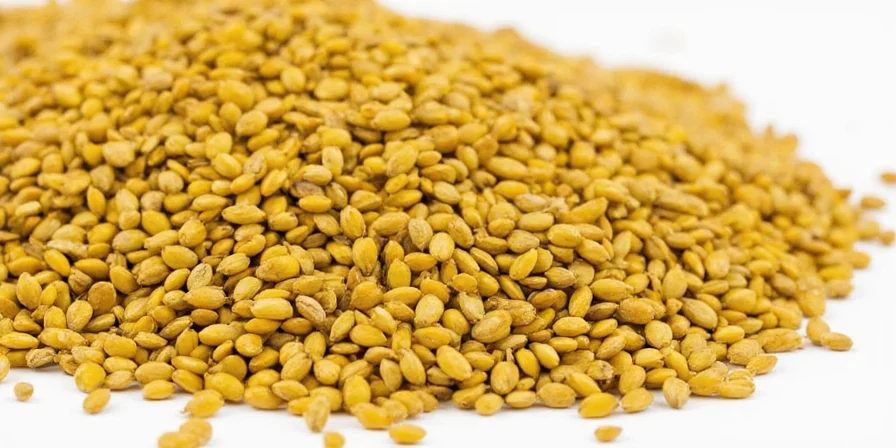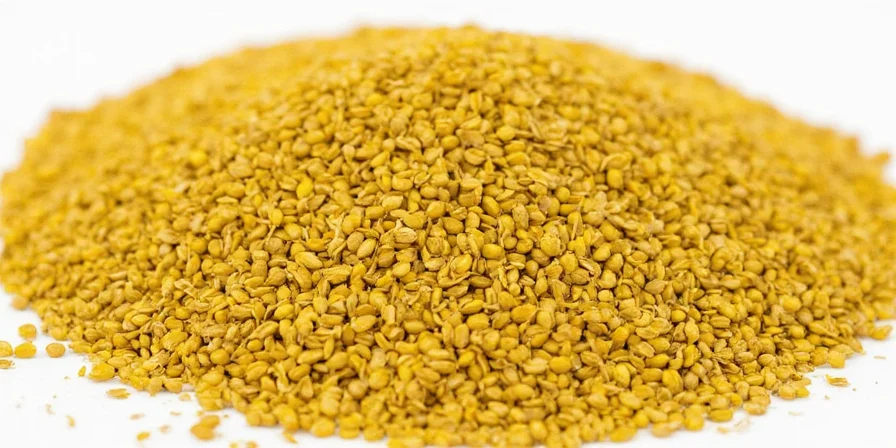Yellow mustard seeds are small, round seeds from the Brassica alba plant that give classic American yellow mustard its mild, tangy flavor. Unlike spicier brown or black varieties, they're perfect for pickling, salad dressings, and spice blends when you want noticeable mustard flavor without intense heat. Here's exactly how to use them, their key benefits, and why chefs prefer them for specific applications.
Table of Contents
- What Are Yellow Mustard Seeds? (Simple Explanation)
- Flavor Profile: Mildness Compared to Other Mustard Seeds
- Top 4 Practical Health Benefits You Should Know
- 7 Easy Ways to Use Yellow Mustard Seeds (With Recipes)
- Yellow vs Brown vs Black Mustard Seeds: When to Use Each
- Why Chefs Choose Canadian Yellow Mustard Seeds
- Quick Answers to Common Questions
What Are Yellow Mustard Seeds? (Simple Explanation)
Yellow mustard seeds are the pale golden seeds from the white mustard plant (Brassica alba). They're smaller and milder than brown or black mustard seeds, which is why they're used in classic American yellow mustard. When whole, they have a nutty, slightly bitter taste that transforms into a tangy flavor when ground and mixed with liquid. Unlike their spicier cousins, yellow seeds won't overwhelm your dishes with heat, making them perfect for beginners and everyday cooking.

Flavor Profile: Mildness Compared to Other Mustard Seeds
If you've ever wondered why yellow mustard tastes different from spicy brown mustard, it's all about the seeds. Yellow mustard seeds deliver these key flavor characteristics:
- Mild tanginess (only 30-40% as hot as brown mustard seeds)
- Nutty flavor when toasted (perfect for spice blends)
- Clean finish that doesn't linger like spicier varieties
- Brightens dishes without overpowering other ingredients
Pro Tip: For the best flavor, toast whole seeds in a dry pan for 2-3 minutes until fragrant before using. This simple step unlocks their full nutty potential without bitterness.

Top 4 Practical Health Benefits You Should Know
While not a miracle food, yellow mustard seeds offer these evidence-backed benefits that make them worth including in your kitchen:
- Digestion Support: Stimulates digestive enzymes naturally - add 1 tsp to heavy meals
- Antioxidant Boost: Contains selenium which helps protect cells from damage
- Heart-Friendly: Magnesium content supports healthy blood pressure levels
- Metabolism Helper: Mild thermogenic effect may support healthy metabolism
Important Note: These benefits are most pronounced when using whole or freshly ground seeds. Pre-made mustard contains vinegar which affects some compounds, but still retains value.

7 Easy Ways to Use Yellow Mustard Seeds (With Recipes)
Move beyond basic mustard with these simple, tested techniques anyone can do:
- Perfect Pickling Spice: Add 1 tbsp to your next pickle brine for classic flavor (no need to crush)
- Homemade Mustard in 5 Minutes: Blend 2 tbsp seeds, 1/4 cup vinegar, 1 tsp turmeric, pinch of salt
- Roasted Vegetable Booster: Toss veggies with 1 tsp seeds before roasting for nutty depth
- Salad Dressing Secret: Whisk 1 tsp ground seeds into vinaigrette to prevent separation
- Meat Rub Foundation: Mix with paprika and garlic powder for chicken or pork
- Quick Pickled Onions: Combine 1/4 cup thinly sliced onions, 1/2 cup vinegar, 1 tsp seeds
- Deviled Egg Upgrade: Add 1/2 tsp to your yolk mixture for subtle complexity
Beginner's Tip: Start with just 1/2 to 1 tsp in recipes. You can always add more, but you can't remove it once added!

Yellow vs Brown vs Black Mustard Seeds: When to Use Each
Understanding these differences will help you choose the right seed for your recipe:
| Characteristic | Yellow Mustard Seed | Brown Mustard Seed | Black Mustard Seed |
|---|---|---|---|
| Heat Level | Mild (good for beginners) | Medium-Hot | Very Hot |
| Best For | Pickling, dressings, mild sauces | Spicy mustards, Indian cooking | Traditional Dijon, complex sauces |
| Activation Temperature | 140-160°F | 100-120°F | 85-100°F |
| Flavor Duration in Cooking | Long-lasting (up to 45 min) | Moderate (15-20 min) | Short (under 10 min) |
Rule of Thumb: If you want noticeable mustard flavor without heat, choose yellow. For authentic Indian flavors, go with brown. For traditional European mustards, black is best.

Why Chefs Choose Canadian Yellow Mustard Seeds
Most commercial yellow mustard comes from Canadian prairies (especially Saskatchewan) because these seeds offer consistent quality and sustainable benefits:
- Grows with minimal water compared to other crops
- Naturally improves soil health for future crops
- Requires fewer pesticides than many alternatives
- Supports crop rotation that reduces fertilizer needs
Practical Impact: When you buy products made with Canadian yellow mustard seeds, you're supporting farming practices that use 30% less synthetic fertilizer. Look for "Canadian Yellow Mustard" on ingredient labels for the most reliable quality.
Quick Answers to Common Questions
Can I substitute yellow mustard seeds for brown?
Yes, but use 50% more yellow seeds for similar flavor impact. Yellow seeds are milder, so you'll need more to get close to brown mustard's intensity. Best for vinegar-based recipes rather than oil-based ones.
Why does my homemade mustard separate?
This happens when seeds aren't properly activated. Solution: Grind seeds finely, mix with vinegar, and let sit for 10-15 minutes before adding other ingredients. The seeds need time to release their natural binding compounds.
How long do mustard seeds last?
Whole seeds stay fresh for 2-3 years in an airtight container. Ground seeds lose potency in 3-6 months. Test by crushing a seed - if it has a sharp aroma, it's still good.
Are yellow mustard seeds good for you?
Yes, in moderation. They contain beneficial compounds that support digestion and provide antioxidants. One teaspoon daily in cooking offers benefits without overwhelming your system.
What's the difference between yellow mustard seeds and regular mustard?
Yellow mustard seeds are the raw ingredient. Regular yellow mustard is made from these seeds plus vinegar, turmeric, and other ingredients. The seeds themselves have a nuttier, less tangy flavor than prepared mustard.
Make the Most of Your Yellow Mustard Seeds
Yellow mustard seeds are your secret weapon for adding depth without heat to everyday cooking. By understanding their mild nature and long-lasting flavor, you can use them in pickling, dressings, and spice blends where stronger varieties would overwhelm. Start with small amounts (1/2 to 1 tsp), toast them for extra nuttiness, and remember they work best with vinegar-based preparations. Whether you're making quick pickles or enhancing roasted vegetables, these tiny seeds deliver big flavor that's accessible to cooks of all skill levels. Keep a jar in your pantry - you'll find endless ways to use them once you know their simple strengths.










 浙公网安备
33010002000092号
浙公网安备
33010002000092号 浙B2-20120091-4
浙B2-20120091-4